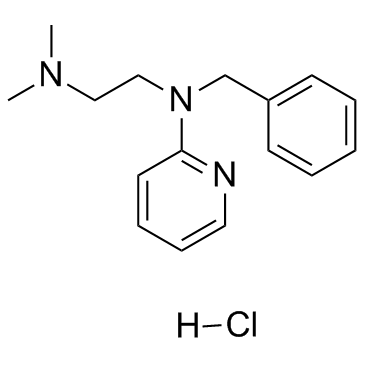Tripelennamine (hydrochloride)

Tripelennamine (hydrochloride) structure
|
Common Name | Tripelennamine (hydrochloride) | ||
|---|---|---|---|---|
| CAS Number | 154-69-8 | Molecular Weight | 291.81900 | |
| Density | 1.20 | Boiling Point | 387.8ºC at 760 mmHg | |
| Molecular Formula | C16H22ClN3 | Melting Point | 192-193ºC | |
| MSDS | Chinese USA | Flash Point | 188.3ºC | |
| Symbol |

GHS07 |
Signal Word | Warning | |
Use of Tripelennamine (hydrochloride)Tripelennamine Hcl, a H1-receptor antagonist, is a psychoactive drug and member of the pyridine andethylenediamine classes that is used as an antipruritic and first-generation antihistamine.IC50 Value:Target: Histamine H1 receptorTripelennamine can be used in the treatment of asthma, hay fever, rhinitus and urticaria.in vitro: Arterial and mixed venous blood-gas and pH measurements were made at rest before and after saline or drug administration and during incremental exercise leading to maximal exertion at 14 m/s on 3.5% uphill grade for 120 s. Galloping at this workload elicited maximal heart rate and induced exercise-induced pulmonary hemorrhage in all horses in both treatments, thereby indicating that capillary stress failure-related pulmonary injury had occurred [1].in vivo: The data obtained (median and range in brackets) in camels and horses, respectively, were as follows: the terminal elimination half-lives were 2.39 (1.91-6.54) and 2.08 (1.31-5.65) h, total body clearances were 0.97 (0.82-1.42) and 0.84 (0.64-1.17)L/h/kg. The volumes of distribution at steady state were 2.87 (1.59-6.67) and 1.69 (1.18-3.50) L/kg, the volumes of the central compartment of the two compartment pharmacokinetic model were 1.75 (0.68-2.27) and 1.06 (0.91-2.20) L/kg [2]. After intramuscular administration of 50 or 100 mg tripelennamine, mean plasma concentrations at 30 minutes were 105 and 194 ng/ml, respectively, and mean plasma t1/2 values were 2.9 and 4.4 hours, respectively [3]. |
| Name | tripelennamine hydrochloride |
|---|---|
| Synonym | More Synonyms |
| Description | Tripelennamine Hcl, a H1-receptor antagonist, is a psychoactive drug and member of the pyridine andethylenediamine classes that is used as an antipruritic and first-generation antihistamine.IC50 Value:Target: Histamine H1 receptorTripelennamine can be used in the treatment of asthma, hay fever, rhinitus and urticaria.in vitro: Arterial and mixed venous blood-gas and pH measurements were made at rest before and after saline or drug administration and during incremental exercise leading to maximal exertion at 14 m/s on 3.5% uphill grade for 120 s. Galloping at this workload elicited maximal heart rate and induced exercise-induced pulmonary hemorrhage in all horses in both treatments, thereby indicating that capillary stress failure-related pulmonary injury had occurred [1].in vivo: The data obtained (median and range in brackets) in camels and horses, respectively, were as follows: the terminal elimination half-lives were 2.39 (1.91-6.54) and 2.08 (1.31-5.65) h, total body clearances were 0.97 (0.82-1.42) and 0.84 (0.64-1.17)L/h/kg. The volumes of distribution at steady state were 2.87 (1.59-6.67) and 1.69 (1.18-3.50) L/kg, the volumes of the central compartment of the two compartment pharmacokinetic model were 1.75 (0.68-2.27) and 1.06 (0.91-2.20) L/kg [2]. After intramuscular administration of 50 or 100 mg tripelennamine, mean plasma concentrations at 30 minutes were 105 and 194 ng/ml, respectively, and mean plasma t1/2 values were 2.9 and 4.4 hours, respectively [3]. |
|---|---|
| Related Catalog | |
| References |
| Density | 1.20 |
|---|---|
| Boiling Point | 387.8ºC at 760 mmHg |
| Melting Point | 192-193ºC |
| Molecular Formula | C16H22ClN3 |
| Molecular Weight | 291.81900 |
| Flash Point | 188.3ºC |
| Exact Mass | 291.15000 |
| PSA | 19.37000 |
| LogP | 3.45180 |
| Vapour Pressure | 3.21E-06mmHg at 25°C |
| Storage condition | Refrigerator |
CHEMICAL IDENTIFICATION
HEALTH HAZARD DATAACUTE TOXICITY DATA
MUTATION DATA
|
| Symbol |

GHS07 |
|---|---|
| Signal Word | Warning |
| Hazard Statements | H302-H315-H319-H335 |
| Precautionary Statements | P301 + P312 + P330-P305 + P351 + P338 |
| Personal Protective Equipment | dust mask type N95 (US);Eyeshields;Faceshields;Gloves |
| Hazard Codes | Xn: Harmful; |
| Risk Phrases | R22 |
| Safety Phrases | 26-36 |
| RIDADR | NONH for all modes of transport |
| WGK Germany | 3 |
| RTECS | US3150000 |
| HS Code | 2933399090 |
| HS Code | 2933399090 |
|---|---|
| Summary | 2933399090. other compounds containing an unfused pyridine ring (whether or not hydrogenated) in the structure. VAT:17.0%. Tax rebate rate:13.0%. . MFN tariff:6.5%. General tariff:20.0% |
|
Translating clinical findings into knowledge in drug safety evaluation--drug induced liver injury prediction system (DILIps).
J. Sci. Ind. Res. 65(10) , 808, (2006) Drug-induced liver injury (DILI) is a significant concern in drug development due to the poor concordance between preclinical and clinical findings of liver toxicity. We hypothesized that the DILI typ... |
|
|
Developing structure-activity relationships for the prediction of hepatotoxicity.
Chem. Res. Toxicol. 23 , 1215-22, (2010) Drug-induced liver injury is a major issue of concern and has led to the withdrawal of a significant number of marketed drugs. An understanding of structure-activity relationships (SARs) of chemicals ... |
|
|
A predictive ligand-based Bayesian model for human drug-induced liver injury.
Drug Metab. Dispos. 38 , 2302-8, (2010) Drug-induced liver injury (DILI) is one of the most important reasons for drug development failure at both preapproval and postapproval stages. There has been increased interest in developing predicti... |
| Ahistamin |
| Tripelennamine (hydrochloride) |
| EINECS 205-833-5 |
| ReCovr |
| dehistin |
| pyrabenzamine |
| pyrinamine |
| piristin |
| stanzamine |
| Tripelenamin*HCl |
| TRIPELENAMINEHCL |
| Azaron |
| tri-tumine |
| tripelennamine HCl |